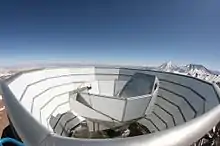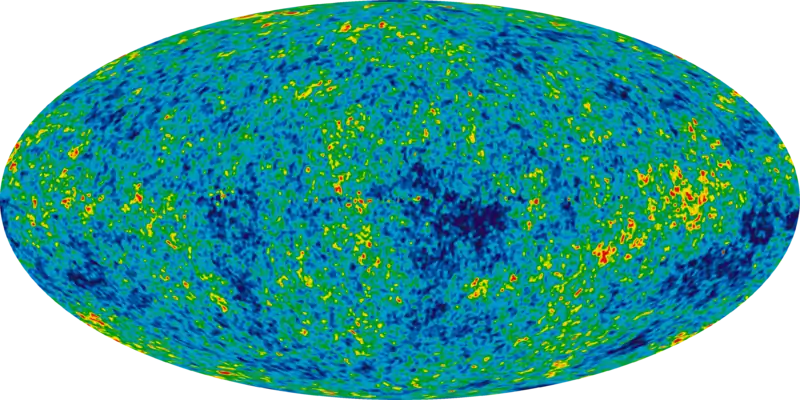Atacama Cosmology Telescope
The Atacama Cosmology Telescope (ACT) is a six-metre telescope on Cerro Toco in the Atacama Desert in the north of Chile, near the Llano de Chajnantor Observatory. It is designed to make high-resolution, microwave-wavelength surveys of the sky in order to study the cosmic microwave background radiation (CMB). At an altitude of 5,190 metres (17,030 ft), it is one of the highest permanent, ground-based telescopes in the world.[lower-alpha 1]
 The Atacama Cosmology Telescope, with Cerro Toco in the background | |
| Alternative names | ACTpol |
|---|---|
| Part of | Llano de Chajnantor Observatory |
| Location(s) | Atacama Desert |
| Coordinates | 22°57′31″S 67°47′15″W |
| Wavelength | 90, 150, 220, 28, 41 GHz (3.3, 2.0, 1.4, 10.7, 7.3 mm) |
| First light | 22 October 2007 |
| Telescope style | cosmic microwave background experiment radio telescope |
| Website | www |
 Location of Atacama Cosmology Telescope | |
Erected in the (austral) autumn of 2007, ACT saw first light on 22 October 2007 with its science receiver, the Millimeter Bolometer Array Camera (MBAC), and completed its first season in December 2007. It began its second season of observations in June 2008.
The project is a collaboration between Princeton University, Cornell University, the University of Pennsylvania, NASA/GSFC, the Johns Hopkins University, the University of British Columbia, NIST, the Pontificia Universidad Católica de Chile, the University of KwaZulu-Natal, Cardiff University, Rutgers University, the University of Pittsburgh, Columbia University, Haverford College, West Chester University, INAOE, LLNL, NASA/JPL, the University of Toronto, the University of Cape Town, the University of Massachusetts Amherst and York College, CUNY. It is funded by the US National Science Foundation.
Design and location

The ACT is an off-axis Gregorian telescope, with a six-metre (236 in) primary mirror and a two-metre (79 in) secondary mirror. Both mirrors are segmented, consisting of 71 (primary) and 11 (secondary) aluminum panels. Unlike most telescopes which track the rotating sky during observation, the ACT observes a strip of sky, typically five degrees wide, by scanning back and forth in azimuth at the relatively rapid rate of two degrees per second. The rotating portion of the telescope weighs approximately 32 tonnes (35 short tons), creating a substantial engineering challenge. A ground screen surrounding the telescope minimises contamination from microwave radiation emitted by the ground. The design, manufacture and construction of the telescope were done by Dynamic Structures in Vancouver, British Columbia.
Observations are made at resolutions of about an arcminute (1/60th of a degree) in three frequencies: 145 GHz, 215 GHz and 280 GHz. Each frequency is measured by a 3 cm × 3 cm (1.2 in × 1.2 in), 1024 element array, for a total of 3072 detectors. The detectors are superconducting transition-edge sensors, a new technology whose high sensitivity should allow measurements of the temperature of the CMB to within a few millionths of a degree.[2] A system of cryogenic helium refrigerators keep the detectors a third of a degree above absolute zero.
In its currently scheduled survey, the ACT will map about two hundred square degrees of the sky.[3]
Because water vapour in the atmosphere emits microwave radiation which contaminates measurements of the CMB, the telescope benefits from its arid, high-altitude site, located in the lofty – yet easily accessible – Chajnantor plain in the Andean mountains in the Atacama Desert. Several other observatories are located in the region, including CBI, ASTE, Nanten, APEX and ALMA.
Science goals

Measurements of cosmic microwave background radiation (CMB) by experiments such as COBE, BOOMERanG, WMAP, CBI and many others have greatly advanced our knowledge of cosmology, particularly the early evolution of the universe. It is expected that higher resolution CMB observations will not only improve the precision of current knowledge, but will also allow new types of measurements. At ACT resolutions, the Sunyaev-Zeldovich effect (SZ), by which galaxy clusters leave an imprint on the CMB, should be prominent. The power of this method of detection is that it is a redshift-independent measurement of the mass of the clusters, meaning that very distant, ancient clusters are as easy to detect as nearby clusters.
It is expected that ACT will detect on the order of 100 such clusters.[3] Together with follow-up measurements in visible and X-ray light, this would provide a picture of the evolution of structure in the universe since the Big Bang. Among other things, this would improve our understanding of the nature of the mysterious Dark Energy which seems to be a dominant component of the universe.
The South Pole Telescope has similar, but complementary, science objectives.
Results
ACT released results measuring the statistical properties of the temperature of the CMB down to arcminute scales in January 2010.[4] It found signals that were consistent with un-resolved point sources and the SZ effect. In 2011, ACT made the first detection of the power spectrum of gravitational lensing of the microwave background,[5] which, combined with the WMAP results, has for the first time provided evidence for dark energy from the CMB alone.[6] Measurements of the CMB power spectrum from the South Pole Telescope were subsequently released [7] that were later also shown to provide evidence for dark energy from the CMB alone.[8]
See also
| Wikimedia Commons has media related to Atacama Cosmology Telescope. |
Notes
- The Receiver Lab Telescope (RLT), an 80 cm (31 in) instrument, is higher at 5,525 m (18,125 ft), but is not permanent as it is fixed to the roof of a movable shipping container.[1] The new University of Tokyo Atacama Observatory is significantly higher than both.
References
- Marrone; et al. (2005). "Observations in the 1.3 and 1.5 THz Atmospheric Windows with the Receiver Lab Telescope". Sixteenth International Symposium on Space Terahertz Technology: 64. arXiv:astro-ph/0505273. Bibcode:2005stt..conf...64M.
- Fowler, J.; et al. (2007). "Optical Design of the Atacama Cosmology Telescope and the Millimeter Bolometric Array Camera". Applied Optics. 46 (17): 3444–54. arXiv:astro-ph/0701020. Bibcode:2007ApOpt..46.3444F. doi:10.1364/AO.46.003444. PMID 17514303. S2CID 10833374.
- Kosowsky, A. (2003). "The Atacama Cosmology Telescope". New Astronomy Reviews. 47 (11–12): 939–943. arXiv:astro-ph/0402234. Bibcode:2003NewAR..47..939K. CiteSeerX 10.1.1.317.3482. doi:10.1016/j.newar.2003.09.003. S2CID 17419249.
- Fowler, A.; et al. (ACT Collaboration) (2010). "The Atacama Cosmology Telescope: A Measurement of the 600 < >>>ℓ < 8000 Cosmic Microwave Background Power Spectrum at 148 GHz". The Astrophysical Journal. 722 (2): 1148–1161. arXiv:1001.2934. Bibcode:2010ApJ...722.1148F. doi:10.1088/0004-637X/722/2/1148. S2CID 8882912.
- Das, S.; et al. (ACT Collaboration) (2011). "The Atacama Cosmology Telescope: Detection of the Power Spectrum of Gravitational Lensing". Physical Review Letters. 107 (2): 021301. arXiv:1103.2124. Bibcode:2011PhRvL.107b1301D. doi:10.1103/PhysRevLett.107.021301. PMID 21797590. S2CID 16368279.
- Sherwin, B. D.; et al. (ACT Collaboration) (2011). "The Atacama Cosmology Telescope: Detection of the Power Spectrum of Gravitational Lensing". Physical Review Letters. 107 (2): 021302. arXiv:1105.0419. Bibcode:2011PhRvL.107b1302S. doi:10.1103/PhysRevLett.107.021302. PMID 21797591. S2CID 13981963.
- Keisler, R.; et al. (SPT Collaboration) (2011). "A Measurement of the Damping Tail of the Cosmic Microwave Background Power Spectrum with the South Pole Telescope". Astrophysical Journal. 743 (1): 28. arXiv:1105.3182. Bibcode:2011ApJ...743...28K. doi:10.1088/0004-637X/743/1/28. S2CID 46121987.
- van Engelen, K.; et al. (SPT Collaboration) (2012). "A measurement of gravitational lensing of the microwave background using South Pole Telescope data". Astrophysical Journal. 756 (2): 142. arXiv:1202.0545. Bibcode:2012ApJ...756..142V. doi:10.1088/0004-637X/756/2/142. S2CID 39214417.

